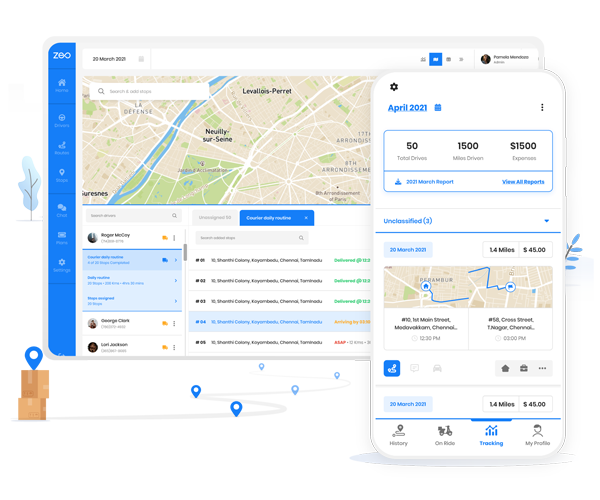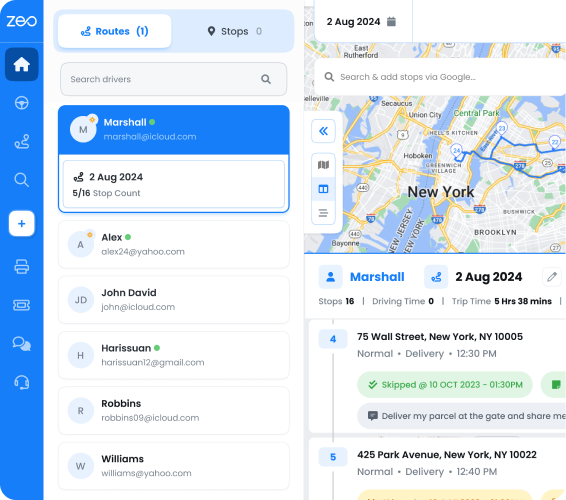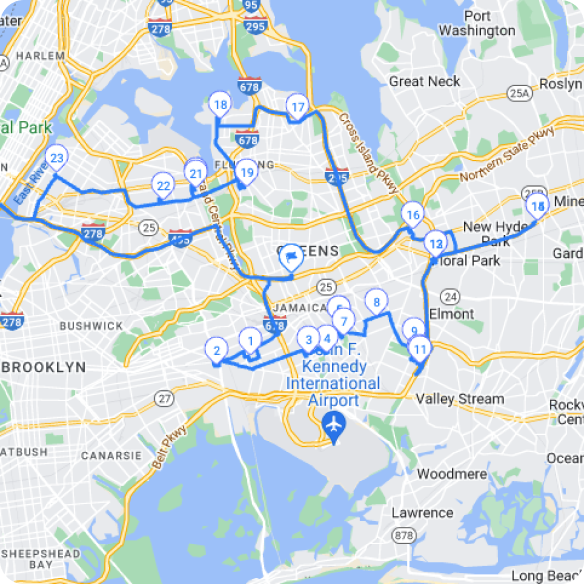Updated on: April 16, 2025
Route planning can be a logistical nightmare when it includes multiple stops. Most of us have used Google Maps for planning routes. Whether you’re a fleet manager planning delivery schedules or an individual looking for a road trip or running errands, Google Maps has been helpful.
It’s one of the basic and trusted navigation tools. But does it allow multi-stop routing? The answer is yes!
Although multi-stop route planning with Google Maps is straightforward, you must be aware of the steps for optimal use along with the few benefits and some drawbacks of the same.
The Need for Multi-Stop Route Planning on Google Maps
When you have to plan routes with multiple stops, you don’t just focus on convenience. The priority must be maximizing efficiency and minimizing costs. Here’s why planning routes with multiple stops is essential for anyone navigating a complex journey:
- Save Time by Avoiding Redundant Routes
Without a structured routing plan, you’re likely to take inefficient paths, backtrack between locations, or overlook stops entirely. With proper multi-stop route planning, you can make every mile count and avoid unnecessary detours.From a business growth perspective, multi-stop route planning enables fleet managers to ensure faster deliveries without missing any timelines.
- Minimize Fuel Consumption and Carbon Footprint
The more a vehicle travels, the more fuel it will consume. In the logistics industry, which deploys numerous vehicles for its operations, fuel consumption becomes one of the most significant business expenses. If not planned properly, it can easily eat into your profits.Ineffective planning of routes with multiple stops leads to unnecessary detours, backtracking, more mileage and increasing fuel costs. The other drawback of this is the adverse impact it has on the environment’s health.
With multi-stop route planning, fleet managers can avoid both. Route optimization helps in reducing the overall travel distance and also minimizes the carbon footprint of your fleet.
- Enhance Customer Satisfaction Through Timely Deliveries
Nothing builds customer trust better than timely and accurate deliveries in the logistics industry. As they say, punctuality is the key to customer satisfaction in delivery operations.
With multi-stop route planning, fleet managers can consider delivery windows as well as the urgency to prioritize stops. Effective planning of routes with multiple stops results in consistent and reliable service.
Plan Routes with Multiple Stops: A Step-wise Guide for Google Maps Users
As we now understand the importance of planning routes with multiple stops, these simple steps will help you with multi-stop route planning on Google Maps:
- Open Google Maps on your device.
- Click on the Directions button which will open a dialogue box.
- Enter the Starting Point.
- Enter the Destination.
- Click on ‘Add Destination’ button just below the last location entry.
- Enter the next Destination.
- Repeat steps 5 and 6 to add multiple stops in your route.
- Drag and reorder the destinations, if required.
Drawbacks of Using Google Maps for Multi-Stop Route Planning
The benefits of multi-stop route planning with Google Maps are notable, however, it can fall short of your expectations in certain aspects. You must be aware of these drawbacks before planning routes with multiple stops on Google Maps:
- No Route Optimization for Efficiency
While Google Maps allows you to schedule routes with multiple stops, it isn’t the ideal route optimization tool. Google Maps fails to automatically optimize multi-stop routes for you and it doesn’t consider factors like traffic congestion, road conditions, and delivery timelines to provide the most efficient route.Users are expected to manually arrange or rearrange the stops as per their understanding. This can result in detours and inefficient fuel usage. For fleet managers or delivery drivers, this lack of route optimization can significantly impact productivity and increase operational costs.
- Limited Number of Stops
Google Maps is an ideal navigation tool when the stakes are low and the requirements are not that high. If your route includes more than ten stops, then this might not be the right tool for you.increase fuel savings
Hassle Free Deliveries & Pickups!
Optimize routes with our algorithm, reducing travel time and costs efficiently.
Get Started for FreeMulti-stop route planning with Google Maps is restricted to only ten stops per route, including the starting point. For fleet managers looking to handle complex delivery schedules with more delivery stops, using Google Maps will lead to more challenges than solutions.
Using Google Maps for more than 10 stops requires creating additional routes. This complicates the routing process and can also result in ineffective route planning.
- No Performance Analytics or Reporting
If you compare the data insights and route analytics provided by a robust route planner like Zeo and Google Maps, you will notice a chalk-and-cheese difference. Google Maps, at most, will provide you the historical data of the routes travelled.There will be no insights into the route efficiency, delivery times, fuel usage, driver performance, or missed delivery windows.
Lack of these insights will handicap the fleet managers as they won’t be able to analyze fleet performance and identify any inefficiencies to improve the process.
- No Proof of Delivery Features
The delivery is not considered complete when the driver delivers the shipment; it is considered complete once the customer accepts it and there is some proof of delivery to testify that.Unlike route planners, Google Maps doesn’t offer inbuilt proof of delivery mechanism. This might compel businesses to rely on separate methods or manual processes to confirm delivery completion status, which can lead to inefficiencies and errors.
- Poor Driver Communication
In the logistics industry, ensuring smooth operations often requires instant updates, rerouting instructions, or coordination for emergencies.Google Maps does not facilitate real-time communication between fleet managers and drivers. Nor does it allow any automated delivery updates to customers.
Without timely communication from fleet managers, drivers would carry out the delivery operations in the dark, unaware of new updates or need to reroute. This can lead to detours, inefficient routing, and delayed deliveries.
Conclusion
If you are looking for a basic navigation tool, Google Maps is the ideal option for you. However, if your multi-stop route planning requirements scale to bigger operations, you must explore better route planners with AI-powered capabilities.
Zeo Route Planner proves to be the ideal choice for fleet managers looking to enhance their operational efficiency while improving customer experience. Zeo helps you eliminate the limitations of Google Maps and streamlines your fleet operations with features like automated route optimization, real-time tracking, proof of delivery, and actionable insights for continuous improvement.
Don’t let the limitations hinder your fleet performance. Schedule a demo with Zeo experts today and experience the power of efficient multi-stop route planning.

Are you a fleet owner?
Want to manage your drivers and deliveries easily?
Grow your business effortlessly with Zeo Routes Planner – optimize routes and manage multiple drivers with ease.

increase fuel savings
Save $200 on fuel, Monthly!
Optimize routes with our algorithm, reducing travel time and costs efficiently.
Get Started for Free






























